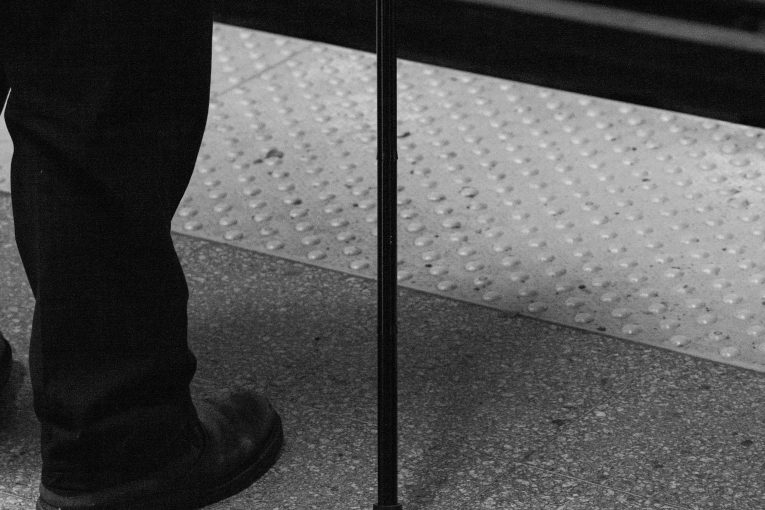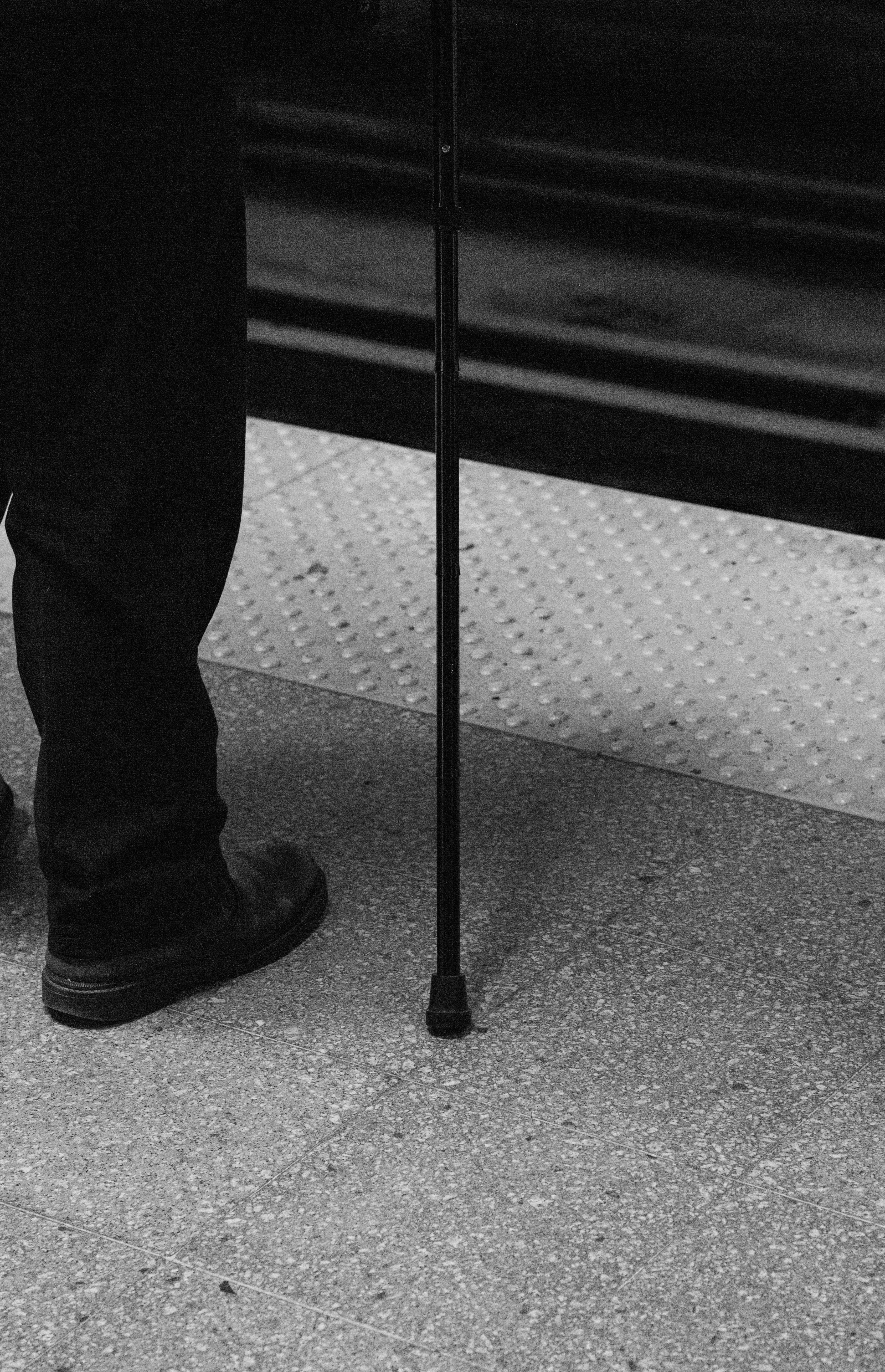


by Jesse Carson
Today I lost my closest companion. He was taken away from me right before my eyes and I didn’t even get a chance to hug him or say goodbye. For five years I went everywhere with him—to work, to school, to eat, to use the phone, even to shower. Yes, today I lost my cane.
I’ve needed a cane to walk since 2004, when I was 23 years old. A genetic disorder called spastic paraplegia causes degeneration in my nerves, resulting in weakness in my legs, hands, and throat. I consider myself fortunate to have had many years of full mobility before this set in, enabling me to run, play sports, serve in the military, amble around Europe, and be a generally foolish kid.
My first cane was a “loaner” from the medical department, a standard wooden cane. I only got the cane at all because of the sympathy of a sergeant visiting the yard who made some phone calls; my doctor’s opinion was that if I could make it into the clinic, then I could get around well enough. After two years I traded up to a newer loaner that someone else had received following a knee injury, exchanging mine for his on the day he was to turn his in.
It only took a few days with a cane to realize that I was going to need some kind of covering for the handle—that wood handle is hard, and starts to splinter right away! I experimented with tape, rolled-up socks, rubber bands, and even laundry bag material. Fortunately, my cellmate loved to crochet, and he made me a custom handle cover that he even loaded up with the stuffing he used in the teddy bears he made. This handle lasted me for some time, until I transferred to another prison in 2007 and it was taken, resulting in me crafting another one out of strips of soft leather and some glue. I relied on the comfort of that handle for another four or five years, until an enthusiastic guard determined that this was “alteration of a medical device” (an infraction I later discovered was imaginary) and had me remove it.
My sister was sympathetic, and offered to send me a cane with a soft handle. I inquired of all the staff I could find what the procedure was for this, but not one person knew—I even spent over an hour with a helpful social worker as he fruitlessly worked his way through the prison’s phone directory for me. Since the rules are clear that it’s allowed, I made the decision to tell my sister to just go for it. A few weeks later, my brand new metal cane—complete with a soft and squishy neoprene handle—arrived. I was called to medical to pick it up, but as soon as the box was opened and the nurse saw an aluminum cane, it was over. “Metal canes aren’t allowed,” she explained, oblivious as I noted the two metal canes and a metal walker I had seen being used on my way to the clinic. It wound up being returned.
Undaunted, my sister found a website run by a military veteran who makes canes out of yew tree roots, and ordered one. I was called to the clinic, to be told that the cane didn’t come from an “approved vendor.” Never mind that not one staff member working in the medical supply department had been able to come up with a list of “approved vendors” just a couple of months ago. It wound up being returned.
My sister persisted. It was now 2013. A wooden cane was ordered from a medical supply company. A “fritz-style” cane, it was shaped like an elongated upside-down “L”. I was called to the clinic, to be told that I couldn’t have this one either. Because the cane is made of two pieces of wood—the shaft and the handle—it screws together, and this joint is covered by a tiny, decorative brass ring, less than one quarter of an inch wide. Due to the metal ring, the nurse said I would have to return it, but I’d finally had enough and filed an appeal. The property officer, responsible for holding on to the cane pending the appeal’s outcome, opined that the ring was just as dangerous as a wedding ring and wished me luck. I was interviewed by medical staff regarding the appeal and why I needed a cane other than the one they gave me; I showed my red and calloused hand and explained the circumstances. It seemed to go well.
While waiting for the official response, I was called to transfer to another prison. The property officer smiled as he packed all my things to go with me, and made sure the cane made it in with everything. When I picked up my property at the next prison, I was given my new cane with no trouble whatsoever. A couple of months later, the appeal response finally showed up: denied. I still keep it, just for a laugh.
This wonderful cane lasted me over a year before the handle broke. I was sad to go from the soft, smooth, straight handle back to the rough, hard curve of my “backup cane” as I called my old one. Fortunately, in the meantime I’d gotten an orthotic brace to help me walk, so while I had it on I didn’t need to lean as heavily on the painful handle.
Once more my sister came to the rescue. She told me about this aluminum cane she was excited about and even sent me an ad she saw on the internet. I showed it to my boss, who was a sergeant, and asked him who was responsible for approving things like this. He looked into it, and said that he approved it, and then instructed me to have my sister send it to the prison in his name. When it arrived, he picked it up and then gave it to me, informing my doctor that he had issued me a new cane and my medical file would need to be updated.
My new cane was a delight. Black aluminum with a comfortable neoprene handle, it had a swiveling three-footed base that made it the most stable cane I’ve ever used. My Hurrycane (the brand name) was superb at handling the pothole-riddled track and even the grassy yard itself that was textured something like Albrecht Dürer’s study on the folds on drapery. It even had a small knitted loop at the end of the handle which I placed my wrist through to keep the cane by my side always. The cane was liberating: lightweight, comfortable to use, stable—almost as good as having full use of my leg. Even when it got old enough that it could no longer stand on its own, it could still rest at an angle without fear of tilting one way or the other and falling all the way to the ground. In time a screw broke inside, but was replaced by maintenance. We went out to medical appointments together, survived scorching summers together, avoided riots together, made a two-day bus trip to another prison together, and even jogged a few laps together.
But the least durable part was the handle. It began pulling apart after a year or two, so I sewed it together, but the threads just formed a new edge from which to separate. It was becoming more thread and bare metal than handle, but I didn’t know how to replace it. A few months ago, the prison started issuing aluminum canes, some of which had the same type of handle, so I thought I’d ask for a replacement during my doctor appointment this afternoon. It was a bad idea.
The doctor went in search of a handle, and returned with a nurse who said they didn’t have any of that kind of handle, only the solid ones that are attached to the new canes—if I wanted a new handle, I’d need a new cane. I politely declined, saying I would continue repairing this one on my own, but the nurse looked at the state of my handle and noted that it could no longer be used for support because the handle was so loose that it spun around. She couldn’t allow me to leave with an “unserviceable medical device.” I tried to find some sort of logical basis for an argument for keeping my companion, but could come up with nothing—there was no way I could talk the nurse into letting me leave with an “unsafe” cane. I wondered aloud if I could just take the upper half of a new one and attach it to the lower half of my Hurrycane, but of course she wasn’t going for the “build your own Franken-cane” argument. I asked if I could think about it, but was told I couldn’t leave, as she would have to note that I had “unserviceable medical equipment” and correctional staff would confiscate it.
Under the pressure of her air-tight reasoning and clear desire to avoid responsibility for some kind of accident (and because I felt bad that this nurse had other things—more important things—to do), I acquiesced. She disappeared, and I sat numbly groping through a sudden fog for anything I might have overlooked. She returned with a new cane, silver and single-footed with a solid gray handle. She handed it to me and seized my old friend. To her credit, she spent a few minutes trying to find a way to attach the loop to this new thing. I will remember the concern she seemed to show then, as if she were aware of how important this was to me. But there was no way to unite the two, so off she went with my old friend. It was unceremonious, quick, like having a Band-Aid ripped off when you didn’t want to see underneath yet.
I don’t like my new cane. It looks like all the other canes, for one thing—it’s no longer unique. Over the barcode and branding stickers, I taped a picture of a bronze sculpture, a serpent entwined about a cross that represents both the object that saved the Israelites in the desert and the cross that saved the rest of us, too. The handle is uncomfortable, harder, and the cane just light enough to make me get used to swinging it as I walk. It’s not as stable, either; it’s fallen several times already, forcing me to awkwardly squat down to retrieve it. But who knows? Maybe I’ll stop resenting it and forge a new friendship with this cane in time.
Republished from “Perspectives from the Cell Block: An Anthology of Prisoner Writings” – edited by Joan Parkin in collaboration with incarcerated people from Mule Creek State Prison.





